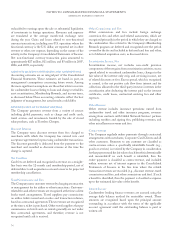American Express 2007 Annual Report Download - page 79
Download and view the complete annual report
Please find page 79 of the 2007 American Express annual report below. You can navigate through the pages in the report by either clicking on the pages listed below, or by using the keyword search tool below to find specific information within the annual report.NOTES TO CONSOLIDATED FINANCIAL STATEMENTS
AMERICAN EXPRESS COMPANY
Goodwill and Other Intangible Assets
Goodwill
Goodwill represents the excess of acquisition cost of an
acquired company over the fair value of assets acquired and
liabilities assumed. Goodwill is included in other assets on the
Consolidated Balance Sheets. The Company assigns goodwill
to its reporting units for the purpose of impairment testing. A
reporting unit is defined as an operating segment, or a business
one level below an operating segment. The Company evaluates
goodwill for impairment annually and between annual tests if
events occur or circumstances change that more likely than not
reduce the fair value of reporting units below their carrying
amounts. In determining whether impairment has occurred,
the Company generally uses a comparative market multiples
approach for calculating fair value.
Intangible assets
Intangible assets, primarily customer relationships, are
amortized over their estimated useful lives of 2 to 14 years on a
straight-line basis. Intangible assets are included in other assets
on the Consolidated Balance Sheets. The Company reviews
intangible assets for impairment quarterly and whenever events
and circumstances indicate that their carrying amounts may not
be recoverable. In addition, on an annual basis, the Company
performs a complete impairment evaluation of all intangible
assets based upon fair value generally using a discounted cash
flow approach. An impairment is recognized if the carrying
amount is not recoverable and exceeds the asset’s fair value.
Other Liabilities
Membership Rewards
The Membership Rewards program allows enrolled
cardmembers to earn points that can be redeemed for a broad
range of rewards, including travel, entertainment, retail
certificates, and merchandise. The Company establishes
balance sheet reserves which represent the estimated cost
of points earned to date that are ultimately expected to be
redeemed. Also, these reserves reflect management’s judgment
regarding overall adequacy. A weighted average cost per point
redeemed during the previous 12 months is used to approximate
future redemption costs and is affected by the mix of rewards
redeemed. Management uses models to estimate ultimate
redemption rates based on historical redemption statistics, card
product type, year of program enrollment, enrollment tenure
and card spend levels. During 2007, management enhanced
the ultimate redemption rate models by incorporating more
sophisticated statistical and actuarial techniques to better
estimate ultimate redemption rates of points earned to date by
current cardmembers given redemption trends and projected
future redemption behavior.
The provision for the cost of Membership Rewards points
is included in marketing, promotion, rewards and cardmember
services and the balance sheet reserves are included in other
liabilities. The Company continually evaluates its reserve
methodology and assumptions based on developments in
redemption patterns, cost per point redeemed, and other factors.
Derivative Financial Instruments and Hedging Activities
All derivatives are recognized on balance sheet at fair value
as either assets or liabilities. The fair value of the Company’s
derivative financial instruments are determined using either
market quotes or valuation models that are based upon the net
present value of estimated future cash flows and incorporate
current market data inputs. The Company reports its derivative
assets and liabilities in other assets and other liabilities,
respectively, on a net by counterparty basis where management
believes it has the legal right of offset under enforceable netting
arrangements. The accounting for the change in the fair value
of a derivative financial instrument depends on its intended use
and the resulting hedge designation, if any, as discussed below.
Cash flow hedges
A cash flow hedge is a derivative designated to hedge the exposure
of variable future cash flows that is attributable to a particular
risk associated with an existing recognized asset or liability, or a
forecasted transaction. For derivative financial instruments that
qualify as cash flow hedges, the effective portions of the gain
or loss on the derivatives are recorded in accumulated other
comprehensive (loss) income and reclassified into earnings
when the hedged cash flows are recognized into earnings.
The amount that is reclassified into earnings is presented in
the Consolidated Statements of Income with the hedged
instrument or transaction impact, primarily in interest expense.
Any ineffective portion of the gain or loss, as determined by the
accounting requirements, is reported as a component of other,
net expense. If a hedge is de-designated or terminated prior
to maturity, the amount previously recorded in accumulated
other comprehensive (loss) income is recognized into earnings
over the period that the hedged item impacts earnings. If a
hedge relationship is discontinued because it is probable that
the forecasted transaction will not occur according to the
original strategy, any related amounts previously recorded in
accumulated other comprehensive (loss) income are recognized
into earnings immediately.
Fair value hedges
A fair value hedge is a derivative designated to hedge the
exposure of future changes in the fair value of an asset or
liability, or an identified portion thereof that is attributable to a
particular risk. For derivative financial instruments that qualify
as fair value hedges, changes in the fair value of the derivatives,
as well as of the corresponding hedged assets and liabilities are
77
























